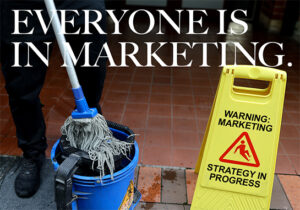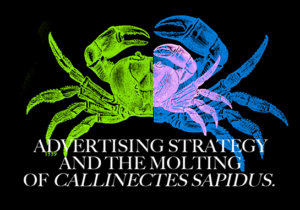
The lifecycle of the forest, and advertising.
Our story begins with a bang. A volcano erupts. An ice age ends. A meteor slams into the earth. Through some seismic upheaval or sedimentary action, dry land rises up out of the sea.
Through natural process, plant life begins. In the beginning, all kind of the same. But some of these plants begin to evolve to grow larger and faster than their neighbors, gobbling up resources, crowding at least some of them out. The larger plants become trees, their crowns eagerly consuming more than their fair share of sunlight, forcing the rest to learn to live in the shade.
As the forest reaches maturity, it reaches a distinct demarcation between the classes of life within: The forest floor, the understory, the canopy, and the overstory. A certain balance is achieved at this stage, with the overlapping lifeforms feeding cycles of growth, even creating a microclimate where nutrients and humidity are controlled by the system.
Then: lightning strikes.
A fire breaks out, consuming the weaker elements of the system. Suddenly everything is either consumed or is too big/tough/resilient enough to burn. The sheer size of the largest trees allows them to survive- Damaged, perhaps, and maybe even forced to grow in different directions. And if they don’t, they become vulnerable to the more aggressive life around them.
But the forest barely resembles the balanced, vibrant ecosystem it was before. It becomes a race for the more resourceful and resilient plants to adapt and bounce back quickly, and this becomes the start of a new cycle, evolving to fill the space the old growth occupied.
Now imagine that we’re not talking about plants at all.
Like the forest, our agencies live in a stratified ecosystem, created over time by a combination of environmental factors, technology, culture, etc. Some are huge and diverse, some small and specialized, but each is optimized to live in the current environment. Which works great until the lightning strikes.
We’ve seen this throughout the history of our industry, and as new technology or cultural revolution appear on the horizon, there are those who can make it through the fire, and those who can’t. But the most successful are those who combine a strong core with the ability to opportunistically thrive on change.
The oldest and biggest are resilient by the simple virtues of momentum and mass, but they are not completely immune to cataclysm in the environment- They have to adapt. They can get hurt in these events, shrink, lose parts, become vulnerable. But they are big enough to survive with their core intact.
The smallest, youngest and most flexible can survive through rapid evolution and adaptation- They lack the weight of legacy systems to hold them back. The ones in the middle, who are either too comfortable, too specialized, too inflexible, or too vulnerable to the imbalances of rapid change, well, they are in big trouble when the lightning strikes.
In my 35-year career, I have witnessed what I would consider at least three of these cleansing forest fires (and we are in the early stages of a fourth), a disruption of culture or business or technology that have irreparably changed the industry, burning down parts of it, forcing the surviving parts to adapt or disappear.
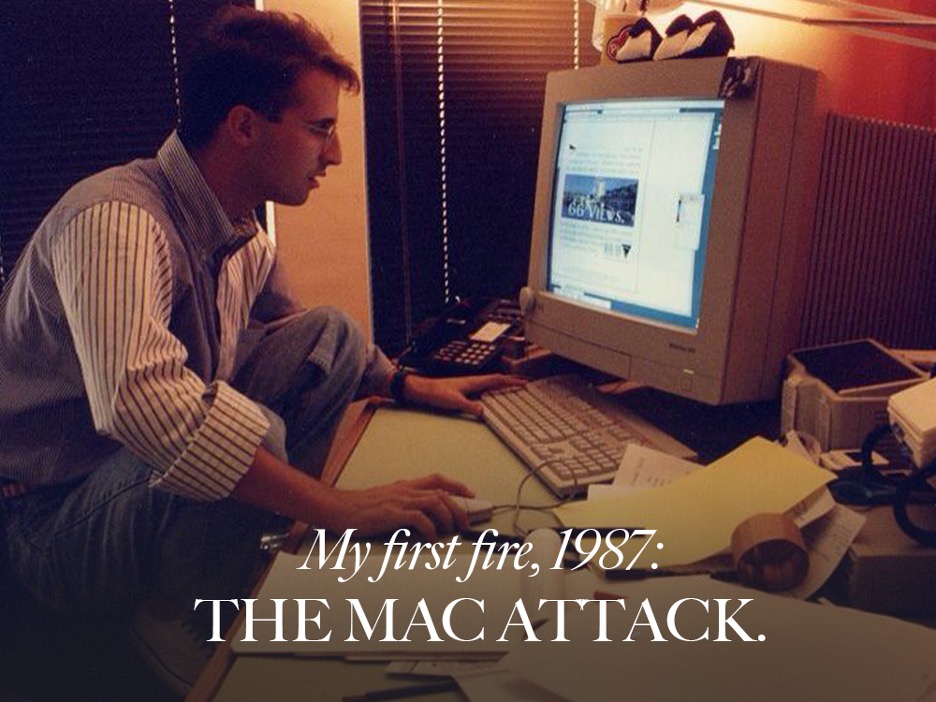
My first fire: The Mac Attack.
The industry I graduated into was one that had not changed a lot in the previous thirty years. The creative revolution of the 1960’s-1970’s had matured into a thriving national landscape of agencies and media, that had grown rampant with the recent emergence of cable television.
But the way we worked hadn’t changed much since the Mad Men era- Anyone who watched that show and thought it seems so quaint and old-fashioned: When I started in 1988, people still smoked in the office, and it wasn’t unusual to use a slide projector in a presentation. The entire process of the business was sprawling, analog and labor intensive.
I got my first job, working in the studio of an ad agency, doing paste-up- again, the same way advertising had been produced for decades. We ordered type from the typesetters, and sent it out to the film houses, proofers and printers (the advent of the fax machine in the late 1980’s was a boon to everyone except the couriers- which might serve as thunder in the distance for the changes to come). You could think of it as a mature forest with 30 or 40 year’s worth of dead wood.
Then the Apple Macintosh II computer appeared. The first generation Macintosh had come along in 1984, and while an interesting case study in human-centric technology, it was a novelty. Computers did exist in the agency before this, but the early, DOS-based stuff was challenging, expensive and temperamental- These clunky machines were found mostly in Accounting and Media, where they were only kind of useful.
But the Mac II changed everything. It allowed us to do what had been hours of studio work in just minutes. A week’s worth of work for a half-dozen artists could be done by a single person in a day. The entire structure of the agency world changed, maybe not overnight, but over the course of maybe three years. And if you didn’t learn to use the Mac not only as a studio artist but as a creative, you were kind of done.
Our local typesetter had a nice little business, his delivery guys buzzing through town serving a handful of big agencies. I think of him, sometimes, driving around, not realizing that in the space of 18 months, not only would he be out of business, his entire industry would cease to exist. Couriers, film houses, retouchers, all consumed in the forest fire of the digital revolution.
It changed the very structure of agencies, and the way creatives were trained and approached their jobs. In the days before, especially at big agencies, Art Director and Writers oversaw the craft of the advertising, but the dirty work of actually making it lived in the protected confines of the studio. After the Mac, studios got a lot smaller (and faster) and suddenly Art Directors had to be able to actually make suff. This remains true to this day, in fact, our 25-person agency can do more work in one week than the 100 person agency I worked at in 1992 did in a month.
Things settled into a new balance into the mid 1990’s. The new forest found its rhythm, when suddenly new thunder appeared on the horizon in the form of a strange warble echoing through the halls from something no one outside of IT had ever heard of: the modem.
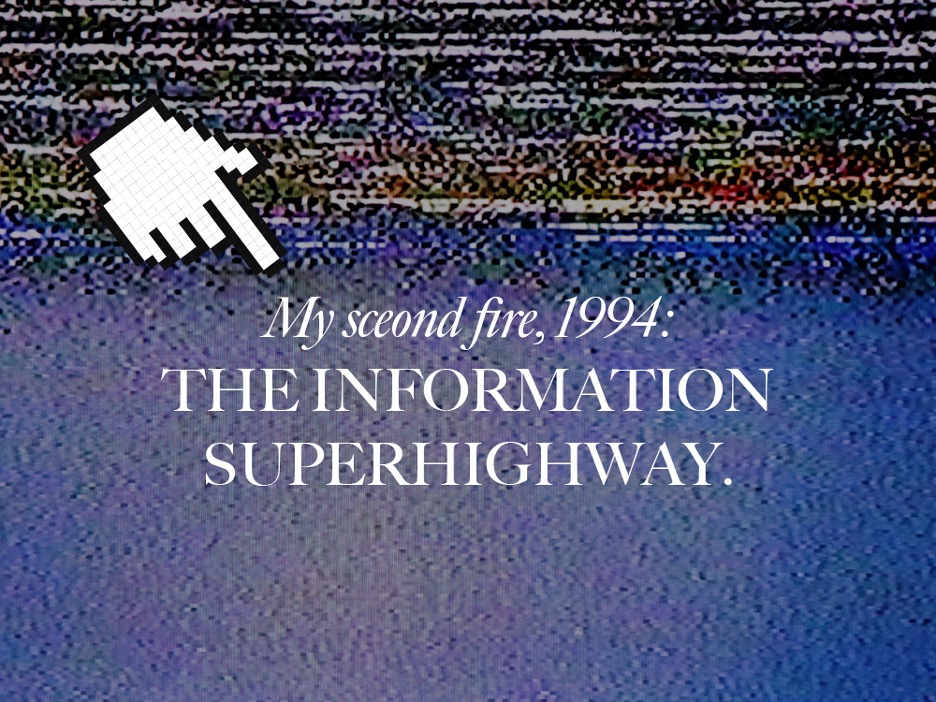
My second fire: The Information Superhighway, 1994.
Oh shit. The Internet. Like the Macintosh before it, it was a marginal novelty until the right pieces fell into place, and then things changed virtually overnight.
First internally: Our original email system appeared in 1994, and at the time, no one knew what it was for, other than to send dumb jokes internally. But once it started catching on outside, and clients started using it, there was no going back- The pace of business intensified, fueled by the frictionless interaction, we used a shitload less paper, and our FedEx bill dropped precipitously. Suddenly, everything became easier. The internet grew in symbiosis with the people using it- Figuring out what it could be used for, and then building those solutions, was a hopscotch of growth. Once again, this changed the shape of the agency- Doing almost anything took fewer people less time.
This also had a dramatic and industry-shifting effect no one saw coming at the time: It gave us a new level of ability to administrate business that wasn’t local in real time. Suddenly an agency in Miami could run a client’s business in Seattle. Which seems good, right?
Unfortunately, the inverse was equally true- Suddenly, a client in Miami could work with a big New York agency without having to rely on local resources. This started a migration of local/regional business to national agencies and a Darwinian selection for small to medium-sized agencies that endures to this day.
When I moved to Miami in 1988, there were probably a dozen mid-sized local shops, each with a roster that included a Cruise Line, an Airline, a Hotel Chain, a Tourism Office, a Rental Car Company, you get the picture. In the years between 1995 and 2005, all that business migrated to big shops in NY, and none of those agencies survive today.
More fundamentally, advertising started appearing in the digital space. What was once a goofy annex relegated to the margins (The “digital guys”) was suddenly thrust into the spotlight. And a thermonuclear device of epic proportion was detonated on the Media department, literally putting their entire landscape into a blender.
It took a little while, but today, all advertising is digital advertising in some fashion. The advent of the internet age was the single biggest disruption to our industry ever. The way consumers experience everything fundamentally changed (and continues to evolve- you could consider the advent of Social Media in the mid 2000’s to be its own cleansing forest fire) The entire calculus of effectiveness, success, consumer engagement, money- All the columns on the scoreboard were transmogrified in the digital cataclysm.
The agencies that emerged were the ones that embraced digital early and often. Experiments like the Subservient Chicken and BMW films showed us that it was a medium that could be harnessed to expand the possibilities. And the extreme targeting that Big Data spawned became “Performance Marketing,” allowing advertising to become weaponized in unprecedented ways.
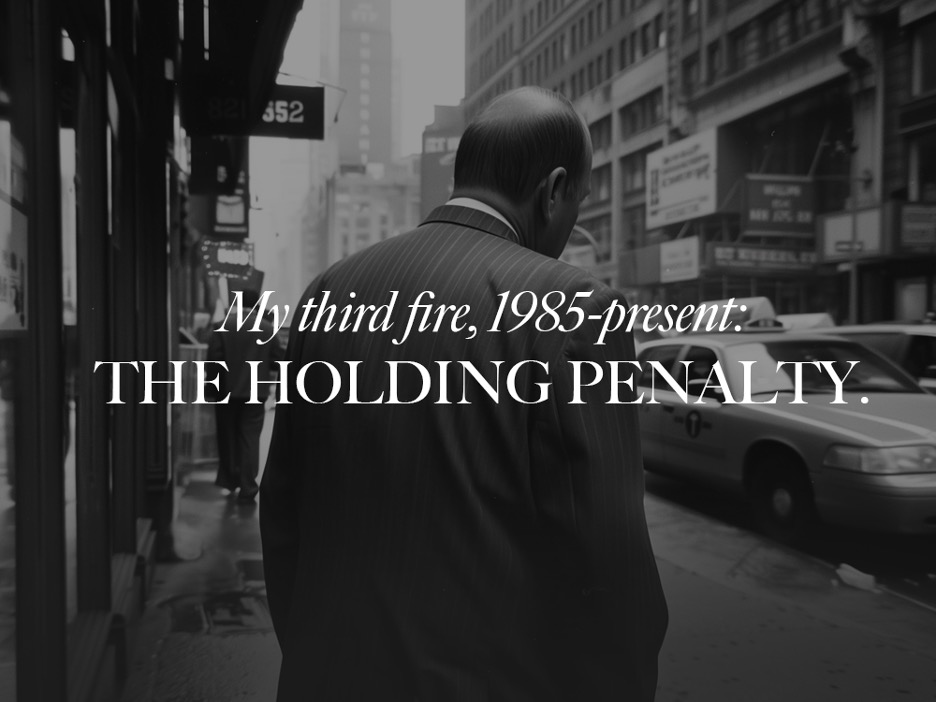
My third fire: The Holding Penalty. 1985- Present
This one requires taking a macro view, because while less obvious to the outside world, it changed the basic topography of the entire industry and controls the very climate that we all operate in today.
In 1985, a humble company that made shopping baskets was purchased by Martin Sorrell and Preston Rabl, with the specific goal to use it as a holding company under which to acquire a range of marketing services organizations. Today, not many folks know that WPP stands for Wire and Plastic Products- They just know it as the world’s largest advertising conglomerate.
About the same time that Sir Martin and co. were cooking this up in the UK, over in New York City, Allen Rosenshine, Keith Reinhard and John Bernbach (son of Bill Bernbach) were engineering a merger between DBB, BBDO and Needham Harper to form what we know today as Omnicom.
The Interpublic Group was formed through a consolidation of McCann-Erickson in the 1930s, but became a true holding company in the 1970’s as they began acquiring subsidiary companies.
Publicis Group was founded almost a century ago, and grew after WW2 to become the world’s fourth largest agency network. In a similar fashion, Dentsu grew out of postwar Japan to become the world’s fifth largest agency network.
The point is, beginning the 1980’s and continuing to today, a period of acquisition, consolidation and mergers changed the very bedrock of the advertising business. What had been a chummy cohort of personality-driven businesses would, over the course of thirty or forty years, become an industry ruled by a very few, very huge public holding companies that are themselves governed by shareholder value and the shifting tides of technology and consumer behavior. And where you once could count dozens of large independent agencies here in the U.S., today you can count them on one hand.
As a result, the goal of many startup agencies for the last twenty years wasn’t to build an agency, but to create an acquisition target. The nature of the name brands of agencies has changed to an alphabet soup of acronyms, buzzwords and subsidiaries where once the Jay Chiats, Leo Burnetts, Hal Rineys and Cliff Freemans once reigned. You were either acquired or you were relegated to obscurity or worse, quietly folded up.

The Current Fire: Robots. 2021- Present
This is the forest we inhabit today. The ecosystem we survive or thrive in. The lightning we see flashing in the distance? Currently more artificial than it is intelligent, but learning fast. Yup. A.I.
Just like that goofy little Macintosh Computer, or a baby tiger, right now it seems cute and harmless. But just like my poor typesetter friend, driving around listening to his Sony Walkman, it’s probably coming to eat you eventually. The few things A.I. has proven to be good at so far, not unlike the Mac or the early Internet, are doing more, faster with fewer people. And like the cleansing forest fires before, it’s going to change things.
Thriving through it all.
The evolution of the forest teaches us a number of lessons. Growing quickly when the sun shines is a competitive advantage. A wide variety of life is key to a thriving ecosystem. Poison Ivy has three leaves. But most fundamentally: No matter how much we feel like we have our shit together, when we hear the thunder getting close, we need to be ready. History has shown us that the most foundational key to not just survival but success is making sure our core is impervious to whatever comes at us.
That means building around something no machine can do and no lightning strike can burn down. Something that can and will always be true, vital, and powerful no matter what technology or media is layered on. And that is our ability to inspire, engage, and touch people through our passion, creativity, and intelligence. Once we have that foundation, adaption becomes a matter of extending these core ethos in whatever unexpected directions the newly emergent world demands.
So bring it on.



